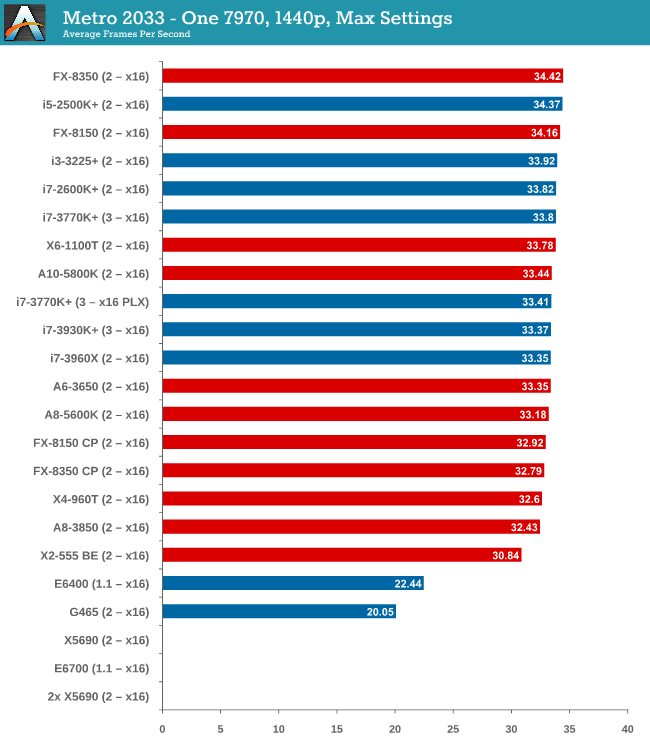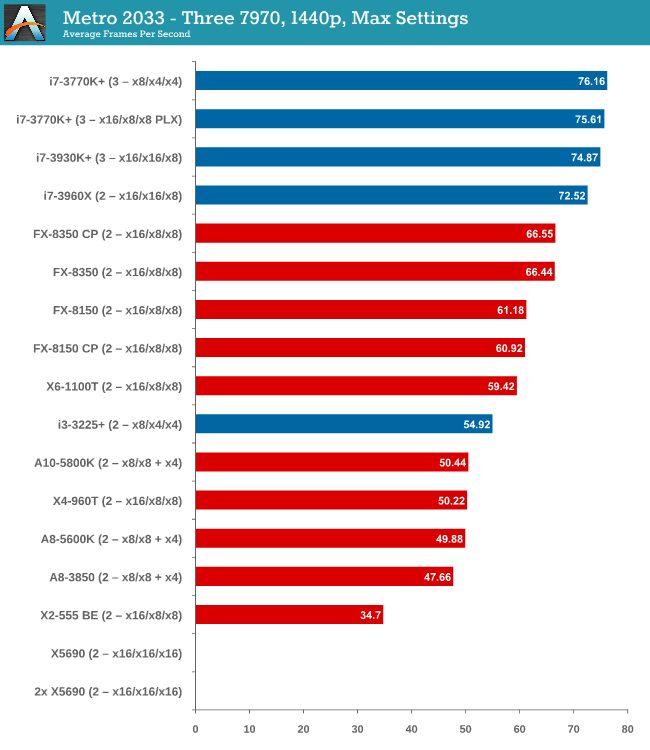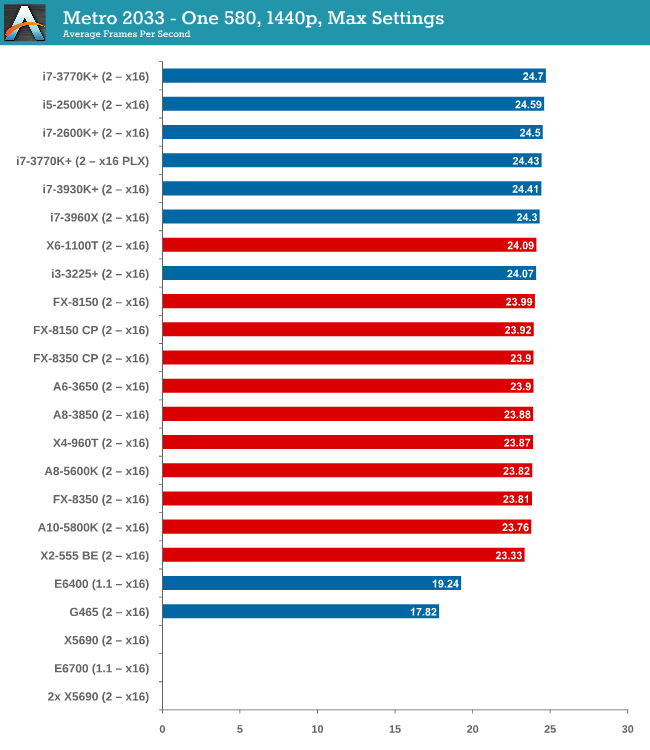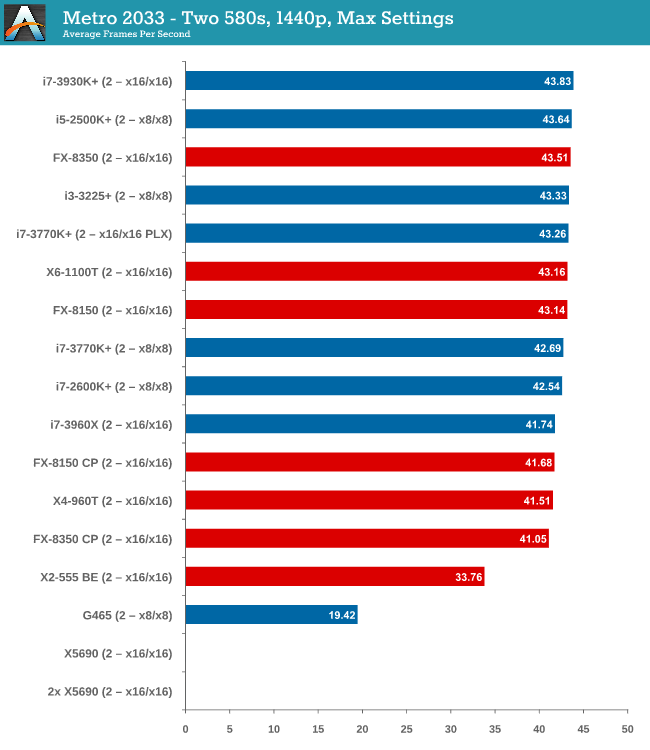Choosing a Gaming CPU: Single + Multi-GPU at 1440p, April 2013
by Ian Cutress on May 8, 2013 10:00 AM ESTMetro 2033
Our first analysis is with the perennial reviewers’ favorite, Metro 2033. It occurs in a lot of reviews for a couple of reasons – it has a very easy to use benchmark GUI that anyone can use, and it is often very GPU limited, at least in single GPU mode. Metro 2033 is a strenuous DX11 benchmark that can challenge most systems that try to run it at any high-end settings. Developed by 4A Games and released in March 2010, we use the inbuilt DirectX 11 Frontline benchmark to test the hardware at 1440p with full graphical settings. Results are given as the average frame rate from a second batch of 4 runs, as Metro has a tendency to inflate the scores for the first batch by up to 5%.
One 7970

With one 7970 at 1440p, every processor is in full x16 allocation and there seems to be no split between any processor with 4 threads or above. Processors with two threads fall behind, but not by much as the X2-555 BE still gets 30 FPS. There seems to be no split between PCIe 3.0 or PCIe 2.0, or with respect to memory.
Two 7970s

When we start using two GPUs in the setup, the Intel processors have an advantage, with those running PCIe 2.0 a few FPS ahead of the FX-8350. Both cores and single thread speed seem to have some effect (i3-3225 is quite low, FX-8350 > X6-1100T).
Three 7970s

More results in favour of Intel processors and PCIe 3.0, the i7-3770K in an x8/x4/x4 surpassing the FX-8350 in an x16/x16/x8 by almost 10 frames per second. There seems to be no advantage to having a Sandy Bridge-E setup over an Ivy Bridge one so far.
Four 7970s

While we have limited results, PCIe 3.0 wins against PCIe 2.0 by 5%.
One 580

From dual core AMD all the way up to the latest Ivy Bridge, results for a single GTX 580 are all roughly the same, indicating a GPU throughput limited scenario.
Two 580s

Similar to one GTX580, we are still GPU limited here.
Metro 2033 conclusion
A few points are readily apparent from Metro 2033 tests – the more powerful the GPU, the more important the CPU choice is, and that CPU choice does not matter until you get to at least three 7970s. In that case, you want a PCIe 3.0 setup more than anything else.










242 Comments
View All Comments
aburhinox - Wednesday, May 8, 2013 - link
This is a great article to compare cpus across multiple gpus. I'd also be curious to see how different GPUs scale. I'd like to see if a single $400 card is better than 2 $200 cards. I'm going to say that given the choice between one or two $400 cards, two is better than one. Going to the extreme would get you to ask if you want to go crazy, if four $100 cards is better than 1 $400 card. That would probably be going too far since you have to end up with expensive motherboards to support four gpus. But I think that would make a useful article about gpus.dwatterworth - Wednesday, May 8, 2013 - link
Thank you for putting the DP Xeon platform in. I imagine it is a niche market but a platform parallel to that in an older generation would be a huge help. I have an aging LGA 771 Asus Z7S-WS board with (2) e5472 procs with (1) 7950 w/boost. The system was built for 3D rendering and architectural work and as 2 systems are not affordable, this became my gaming machine as well. Other than putting my own benchmarks up against what I can find here or other sites it is very hard for me to decide when and to what to upgrade. I greatly appreciate the Xeon inclusion on this as there are some (few?) who fall into the work + play on a single machine scenario.xinthius - Wednesday, May 8, 2013 - link
You, my friend, just made me laugh well and truly, thank you."his intelligence will diminish gradually." Speaking from experience I see?
kyuu - Wednesday, May 8, 2013 - link
Maybe this is a dumb question, but shouldn't the Core Parking updates also be beneficial to the APUs? They're still using the same module architecture as the FX chips.IanCutress - Wednesday, May 8, 2013 - link
That's planned for the next update, after Haswell launch. At the time I completely forgot and went on to the next platform. Need to pull out the FM2 test bed, install an OS and retest them - another day of testing at least (!). But it's on the 'to do' list.Ian
kyuu - Wednesday, May 8, 2013 - link
Cool, thanks for the reply Ian.antonyt - Wednesday, May 8, 2013 - link
This analysis is great! And extremely useful for anyone contemplating a gaming build in the near future (as I am). I look forward to seeing your updates and more articles like this.Btw, minor typo ("future") at the very end--"but we hope on expanding this in the fuiture."
IanCutress - Wednesday, May 8, 2013 - link
Fixed the typo, cheers :)felang - Wednesday, May 8, 2013 - link
Only if you plan to play single player games onlyxinthius - Wednesday, May 8, 2013 - link
You agree with the fact your intelligence has diminished? Okay.I would LOVE to see you design a microprocessor as complex as one of AMDs. Their processors actually perform admirably in highly threaded workloads, while their current architecture is weak in the IPC department. Their CPUs are by no means weak and should still be recommend in some circumstances, such as their APU range. Please try and post intelligently, I know it's hard for you.